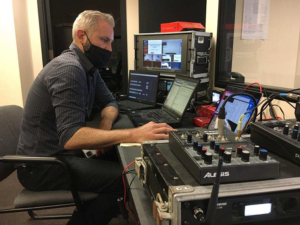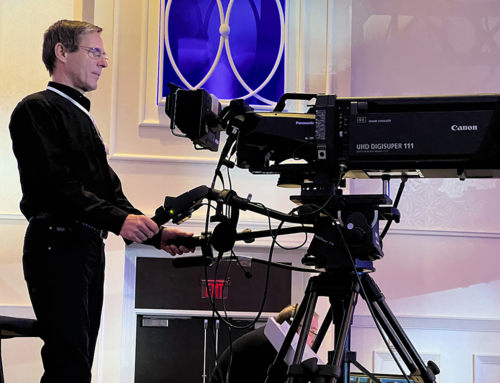
Director/Technical Director/Streaming Tech John Bogley working with Blackmagic ATEM 2 switcher and encoding laptops
MTI is one of the premier companies in the DMV for virtual events, live streaming, and webcasting. Our first live event was back in the prehistoric Internet days of 1998 for Washingtonpost.com. The event was the Washington Area Music Association’s Wammy Awards, presented from the Washington Hilton.
When we receive an inquiry from a client to produce a virtual event, either live or a webcast, we start with the basics. This is meant to give a general overview of the process.
The first thing we need to know, of course, is what is the date of the event? This is so we can get a crew in place. It is also important to know what type of crew you need. For example, we normally prefer to have at least two people on a virtual event/webcast. The reasoning behind this is that if you have just one person starting the stream and running the camera, any problems that arise will require that the videographer/virtual event director to lock down the camera shot and then work on the stream. Splitting focus of the crew can prove problematic.
Many times one camera will suffice; if an additional camera is needed, then MTI will bring in a switcher for the virtual event. We always try to work with clients on budgets, however, this is a live event and it is very important to make sure the stream is clean and without buffering.
Who Is Supplying Audio For This Event?
Is MTI supplying the audio or are we taking a feed from an audio company?
Will there be more than one microphone and/or are we providing speakers in the room?
We also need to know the size of the room to bring the proper equipment. If there is media at the event, MTI can supply a “multi box,” which allows the networks and local stations to plug in and receive a clean audio feed.
We need to know what time the event starts and what time the event finishes. It is helpful to know how many people will be in the live audience at the event and the size of the potential streaming audience.
MTI always monitors its virtual events/webcasts remotely. That way we can text people onsite if audio needs to be raised or lowered, or if something else needs to be adjusted.
Once the crew is reserved, we next need to find out specifics about the event.
Make Sure the Pipes Will Actually Flow
It is critical to have a hard-line connection preferably with at least 10 MBPS upload. There are times that a hard-line is not available. Metro Teleproductions explains to clients that we cannot guarantee the quality of a stream using just wireless technology. For example, if you have 50 people in a room and everyone is on their phone, the quality of the stream can be severely diluted. MTI is happy to speak with the facility, whether it is a conference center, hotel, university, or in a corporate setting. Please note that the client is responsible for any charges for ordering a circuit and ports. The charges vary widely from facility to facility and it is important to know what this will cost.
For clients with expanded budgets, MTI can provide a “Live U,” which combines cell phone capabilities for a broadcast quality signal. Obviously, depending on where you are streaming from, there needs to be a test to make sure that you can get a signal out.
For actual streaming, there are many options. Facebook is free, and if the client has a Youtube account, that is also free. Please note that it is very important for MTI to have access to the accounts. For example on Facebook, we prefer to be made an administrator, which allows us to test the signal privately before the start of the event.
For Youtube, there have been changes in the past year with the service that require the event to be set up properly so that everyone can access it. As we know because of the pandemic, Zoom has become very popular. Sometimes virtual events are done just using Zoom; other times Zoom is mixed with Vimeo or one of the other streaming platforms. If a client desires additional bells and whistles — like pre-registration, secure link, additional reporting, etc. — MTI partners with providers such as Issuer Direct. Because of the pandemic, many times the featured speakers will be remote. It is crucial to know how many and how they are coming into the virtual event. It is always advisable to test out any remote connections in advance of the virtual event/webcast as opposed to the day of. Normally we can do a remote test from anywhere.
Another key area is Powerpoint presentations. If they are being used in the virtual event/webcast, it is important to know how many presenters are using them. Does the remote presenter have any Powerpoints? The same goes for any video footage that is needed for the virtual event.
We recommend that the event be up and running at least 15 or 30 minutes before the advertised start time, so that any last-minute problems can be addressed.
MTI double records every event and can supply a copy of the event either through a cloud service such as Dropbox or on a hard drive.
This is not meant to answer every question you would have. We are happy to plan your virtual event. Give us a call at 301-608-9077 or email dave@mtitv.com
Metro Teleproductions, offering video production in the Washington, D.C., area for 20+ years, is owned and operated by Dave Lilling with creativity, reliability and professional excellence. Contact Dave at 301-608-9077 or for video production success!



